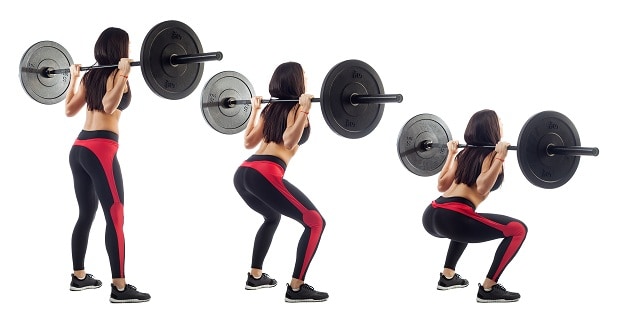How to breathe properly when squatting?
Proper breathing during squats plays a huge role in the benefits and effectiveness of the element. The body spends a lot of energy to perform even one squat, so it needs a sufficient amount of oxygen. Correct breathing ensures it.
Benefits from proper breathing
Proper breathing while squatting is essential for maximum effect. All aerobic and power loads must be accompanied by correct technique and breathing. This is the only way to improve performance and achieve health safety. Breathing technique should be taken more seriously when increasing the weights while squatting. Inhaling and exhaling at the right moment will help you overcome the most difficult moments of the movement. As a result, you will be able to do more reps for optimal muscle development.
The main thing in any training is to replenish th body with oxygen, which it spends in large quantities. Therefore, it is important not only to take deep breaths and exhales, but also to make them at the right time. For example, exhale with maximum effort. In this case, an even distribution of the necessary substances to the internal organs and muscle tissues is ensured. With a sharp filling of the lungs with air or their emptying in jerks, the load on the heart increases. The athlete can overtake hypoxia, accompanied by loss of consciousness right during training.
Types of breath
From the point of view of physiology, breathing is divided into two types:
- Chest breathing. It is inherent in almost all people in ordinary life in a calm state without physical exertion. With this breath, the chest expands and the ribs rise.
- Abdominal breathing. Involves the diaphragm in the breathing process. It changes the volume of the chest, lifting and becoming denser. This type of breathing is developed only in conditions of training and effort. It is deeper and more complete.
Abdominal breathing should be preferred when squatting. When a person is in a calm state, the portion of air that is obtained during chest breathing is enough for normal functioning. When squatting, the diaphragm begins to work along with the lungs. It fills with air, pressing against the inside of the chest, expanding it and increasing the volume of oxygen.
If we do not think about chest breathing, performing inhalation and exhalation at a subconscious level, then abdominal breathing should be learned. The technique is as follows:
- We draw air through the nose and try to direct it to the lungs and stomach area.
- We stick out the stomach slightly forward, expanding it to its maximum size.
- Slowly push the carbon dioxide out through your nose or mouth while pulling in your abdominal muscles and tightening your abs.
When squatting, the exhalation and, accordingly, the retraction of the abdomen should occur at the time of lifting.
Classic Squat Breathing
It is recommended to start mastering the squat technique and proper breathing when performing them with your own weight, that is, without a barbell or dumbbells.
The training will look like this:
- We accept the starting position and release the lungs from carbon dioxide (exhale).
- Smoothly go down, while squeezing the lips tightly, and slowly inhaling the air through the nose. There is no rush here: you still won’t be able to capture more oxygen than your lungs can handle.
- Inhalation must be stopped at the moment when the thighs are parallel to the floor – the time for exhalation begins. Rising, we push carbon dioxide out of the lungs, while the exhalation can be completed at the moment of raising the body only by half, that is, we do it more intensively than when inhaling. You can breathe out through your mouth.
Important point! When performing the element, the arms should not hang along the body – this prevents the chest from expanding. Better to stretch them out in front of you or fold them in front of your chest.
Squats are recommended to be done in several approaches 10-15 times. Between the approaches, a short rest is required in the form of at least five full inhalations and exhalations. You must fully regain your breathing during this rest.
Squat Breathing
Squats with a load allow you to pump up your hips and glutes, as well as develop your abs and lumbar region. Therefore, after mastering the usual squats, you can move on to the option with weights, for example, with a barbell or dumbbells.

In this case, training and, accordingly, breathing will be somewhat different:
- Take a deep breath and a sharp exhale and approach the bar.
- We put the barbell on the shoulders, while we spread our legs, and straighten our back. We remove the projectile from the racks and retreat to a given position. If this process takes a long time, inhale and exhale deeply and measuredly.
- Once again exhale completely, inhale and begin to slowly descend to the set point.
- Lifting, especially with a barbell, requires some effort, so when returning to the starting position, you do not need to rush to exhale. Carbon dioxide should be released without jerking, smoothly through the interlocking teeth or nostrils.
- Upon completion of the straightening, it is necessary to sharply exhale all the remaining carbon dioxide and again fill the lungs with oxygen, immediately descending. You don’t need to straighten your knees and rest.
In any case, barbell squats should be preceded by classic no-weights squats for breathing warm-ups.
Important! Learn to control your breathing from the very first barbell squat. So you can not only avoid various injuries and health problems, but also develop a habit of correct breathing, which in the future will no longer need control. You will breathe correctly in all automatic exercises.
Proper rest
It is important not only to train correctly, but also to rest properly. So, there should be a little rest between the sets of squats. It can last from one to six minutes, depending on the rate of recovery of your breathing and working weight. During rest, breathe only through the nose . At the same time, the breaths should be as deep as possible. Exhales should be slow until the chest is completely empty.
You need to breathe in the same rhythm and return to training only after the full recovery of the pulse and saturation of the body with oxygen. Each new approach should begin with a deep breath to fully open the lungs. The approach should end on exhalation.
Important! Listen to yourself. If you feel that after squats you cannot catch your breath in any way, then the load should be reduced. The body will not wish itself ill: it will always say that it is not ready for so many repetitions or such a load. Raise the bar gradually.
Technique of correct breathing when squatting according to Bubnovsky
Squats are included in the book by Sergei Bubnovsky “50 irreplaceable exercises for health.” The author also recommends combining the execution of the element with the correct breathing technique.
To perform squats, Bubnovsky recommends standing facing a fixed support and grabbing a rubber shock absorber attached to the support. The shock absorber must be tightened and held at chest level. Keep your back and arms straight. On the inhale we do a squat, and on the exhale we rise. In this case, the exhalation should be accompanied by the extension of the legs and the sound “ha-a”. This is the main feature of the combination of breathing and squats according to Bubnovsky. The exhalation should be sharp and the sound clear. It is necessary to push out all the accumulated carbon dioxide with this sound.
Some more features of correct breathing and additional recommendations
Why should you try to breathe only through your nose? Why not inhale deeply and why do you need a breathing warm-up before squats? Let’s move on from practice to theory. Let’s note a number of postulates of correct breathing:
- Inhale through the nose, exhale through the mouth. In the mucous membrane of the respiratory tract there are receptors that signal the supply of oxygen to the brain, therefore, inhale during exercise only through the nose. The mouth can only be used for exhalation. At the same time, with classic squats, a quiet exhalation will be sufficient. A loud exhalation is necessary when working with large weights.
- Correctly alternate inhalation and exhalation. The first breath should be before starting the squat, repeated breaths will be required each time you lower. The exhalation is done on effort, that is, at the lowest point at the time of the beginning of the ascent.
- Do not inhale for future use. Typically, the lung capacity of an adult is six liters. Moreover, the lungs are never completely empty. During inhalation, the maximum allowable amount of air that can be stored is two liters. Therefore, inhaling too deeply at the beginning of the exercise can lead to rapid and shallow breathing. This can lead to an uneven distribution of oxygen through the tissues, which can lead to loss of consciousness.
- Breathing warm-up is the key to successful training. In order for the body to adapt to a kind of breathing during physical activity, it is necessary to prepare the respiratory system. The lungs need to be properly ventilated and circulation improved. This requires breathing exercises at the beginning of any training session.
Instead of a conclusion
Squatting is an exercise in which everything is interconnected: correct breathing facilitates movement, but correct technique also helps maintain breathing. It will become more difficult to breathe when the body collapses backwards or when you exhale early, so you need to focus on both technique and breathing.


